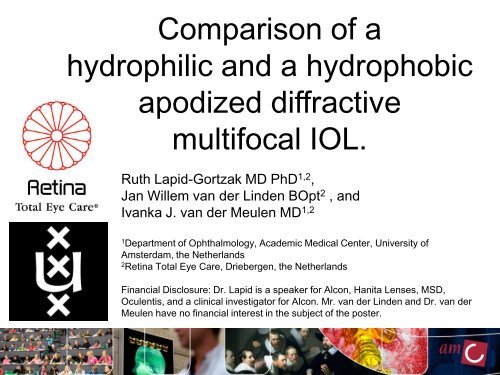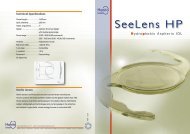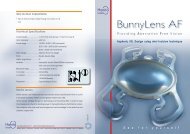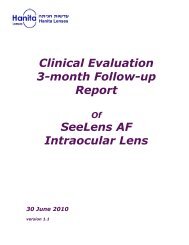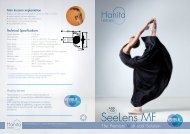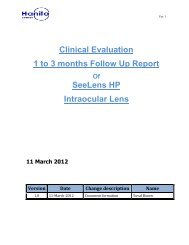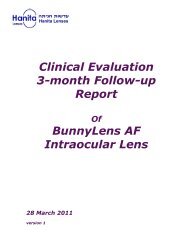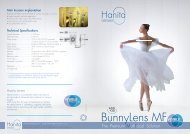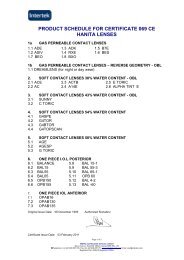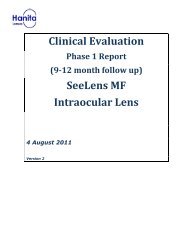Multifocal IOL - Hanita Lenses
Multifocal IOL - Hanita Lenses
Multifocal IOL - Hanita Lenses
You also want an ePaper? Increase the reach of your titles
YUMPU automatically turns print PDFs into web optimized ePapers that Google loves.
Comparison of ahydrophilic and a hydrophobicapodized diffractivemultifocal <strong>IOL</strong>.Ruth Lapid-Gortzak MD PhD 1,2 ,Jan Willem van der Linden BOpt 2 , andIvanka J. van der Meulen MD 1,21Department of Ophthalmology, Academic Medical Center, University ofAmsterdam, the Netherlands2Retina Total Eye Care, Driebergen, the NetherlandsFinancial Disclosure: Dr. Lapid is a speaker for Alcon, <strong>Hanita</strong> <strong>Lenses</strong>, MSD,Oculentis, and a clinical investigator for Alcon. Mr. van der Linden and Dr. van derMeulen have no financial interest in the subject of the poster.
Introduction•<strong>Multifocal</strong> <strong>IOL</strong>s (MF<strong>IOL</strong>) effectively treat ametropia andpresbyopia•Satisfaction with MF<strong>IOL</strong>s depends on patient motivation tobe free of spectacles, and also on the design of the <strong>IOL</strong>optic.•Most optics use a refractive or diffractive pattern toseparate the light into 2 foci – 1 for far and 1 for near. Thiscauses a blur circle of the focus that is not clear, but alsoother visual side effects.•In apodized diffractive MF<strong>IOL</strong>s the ring pattern on theoptic is a source of halos and visual side effects. Changesin this design could lead to a decrease in visual sideeffects.
• The diffractive rings on the optic allow for separationof different foci, and apodization, which is thedifferent height and distance of each ring, allows for amore clear separation of different foci, and theprecise design of these apodized diffractive ringsinfluences the balance between:1. Distance versus near dominance of a MF<strong>IOL</strong>2. Induction of halos by the ring pattern3. Depth of focus of the near focus
The Hydrophilic MF<strong>IOL</strong>Seelens MF(<strong>Hanita</strong> <strong>Lenses</strong>, Israel)Hydrophilic materialOptic 6 mm, haptic 13 mmAspheric, biconvex, posteriorlyangulated haptics 5 011 apodized diffractive rings360 0 posterior square edge ofopticreading addition: +3.0 D
The Hydrophobic MF<strong>IOL</strong>SN6AD1 (“Restor +3”) (Alcon, USA)Hydrophobic Acrysof materialOptic 6 mm, haptic 13 mmAspheric, biconvex, not angulated9 apodized diffractive ringssquare edge of optic and hapticsreading addition: +3.0 D
PurposeTo compare outcomes between a new design apodizeddiffractive hydrophilic multifocal <strong>IOL</strong>( Seelens MF; studygroup), and a well-known apodized diffractivehydrophobic multifocal <strong>IOL</strong> (SN6AD1; control group).Methods•comparative case series•refractive and visual outcomes at distance and near,•patient satisfaction with a validated questionnaire,•dysphotopsia and straylight measurement scores•at 3 months post-operatively.
Results: Uncorrected and CorrectedDistance Visual AcuityFigure 1:Mean uncorrected distance visual acuity(UCDA) up to 6 months form surgery. At alltime points measured postoperatively thestudy group and the control group performedequally in terms of uncorrected distance visualacuity and was not statistically significantlydifferent. @ 3 months: Seelens MF logMAR0.02 + 0.07 vs SN6AD1 0.04 + 0.09.Figure 2:The comparison of the postoperative correcteddistance acuity up to 6 months is shown. Thedifference between the groups is small butstatistically significant in favour of the studygroup (the Seelens MF) -0.04 + 0.05 vscontrol group (SN6AD1) -0.1 + 0.04 (
Results in terms of near visual acuity:Figure 3:UNVA at 40 cm, at different time points in thefollow up period. The study group and thecontrol group perform equally well: logMARSeelens MF 0.09 + 0.12 versus SN6AD1 0.08 +0.08. There were no clinical or statisticallysignificant differences between the groups.Figure 4:The difference in near acuity, without correction,and at different distances is shown in the graph.There is no clinical of statistical difference forthe 30 and 40 cm distance between the studyand control group However, there is a clinicaland statistically significant better reading at 50(p
Demographic data study vs control groupDemographic Study Group Control Group P valueEyes(n) 48 37 -Female sex, n (%) 7(28) 9(45) 0.18Mean age (y) + SD 57.4 + 2.81 59.6 + 7.49 0.14Mean CDVA (logMAR) + SD 0.10 + 0.62 0.09 + 0.13 0.20Indication for Surgery 0.16Cataract, n(%) 28(58) 27(73)RLE, n(%) 20(42) 10(27)
Ocular Parameters: Study vs Control GroupParameter Study Group Control Group P valueSphere (D)Mean + SD1.14 + 1.590.31 + 3.120.051Range-3.5D to +5.75D-6.5D to +5.25DCylinder (D)Mean + SD-0.45 + 0.38-0.67 + 0.320.009Range0 to -1.25-0.25 to -1.50Spherical Equivalent (D)Mean + SD1.19 + 1.68-0.02 + 3.060.035Range-3.88 to +5.13-6.88 to +5.00Axial Lengthmm + SD23.47 + 1.5623.84 +1.780.30Range22.17 to 25.5421.01 to 27.45Anterior Chamber Depthmm + SD3.33 + 0.123.24 + 0.430.34Range2.61-3.932.70-4.56Preoperative Pupil Diameter mm + SD3.39 + 0.213.46 + 0.850.49Range2. to 4.12.3 to 4.6
Visual quality, Halos, and Patient Satisfaction• Straylight changed (improved) from a mean log S of 1.276 + 0.078 in theSeelens MF group to 1.077 + 0.237 (p
Conclusion:• The Seelens MF performs well compared to a well knownmultifocal apodized <strong>IOL</strong>, the SN6AD1.• The lens material and design of the Seelens MF clinically andstatistically significantly improves straylight and quality ofvision. Clinically the incidence of halos was less in the studygroup, however this was statistically not significant.• Near acuity was comparable in both groups, with a clinicallyand statistically significant advantage for the Seelens MF atthe 50-60 cm distances.• The Benz26 material makes the Seelens MF free ofglistenings, but the SN6AD1 is a lens that has been usedmore often, with excellent results, and excellent possibilitiesof accurate <strong>IOL</strong> calculation.


